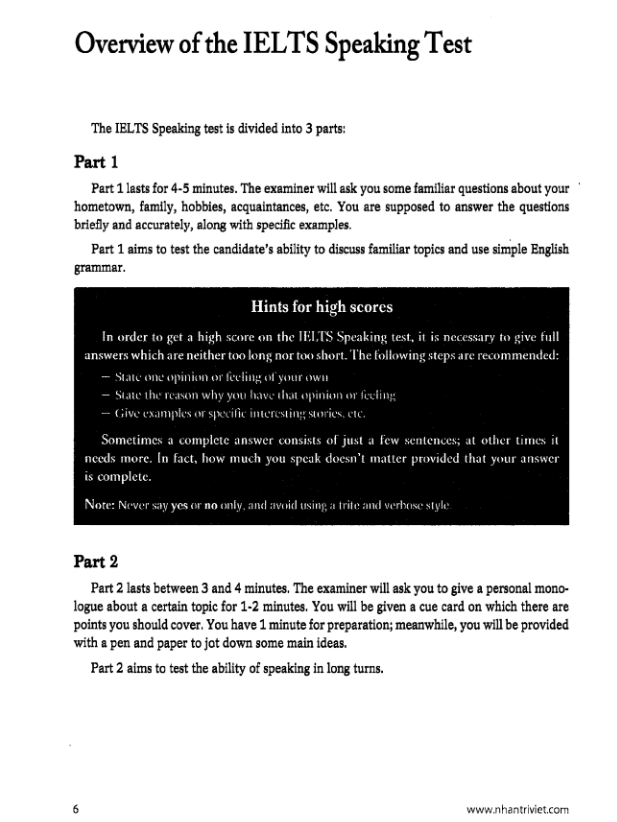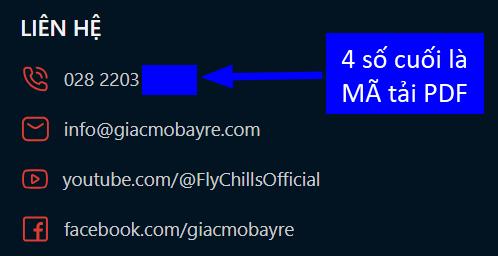


Overview of the IELTS Speaking Test
The IELTS Speaking Test is divided into 3 parts
Part 1
Part 1 lasts for 4–5 minutes. The examiner will ask you some familiar questions about your hometown, family, hobbies, acquaintances, etc.
You are supposed to answer the questions briefly and accurately, along with specific examples.
Purpose:
Part 1 aims to test the candidate’s ability to discuss familiar topics and use simple English grammar.
Hints for High Scores
In order to get a high score on the IELTS Speaking test, it is necessary to give full answers which are neither too long nor too short. The following steps are recommended:
- State one opinion or feeling of your own.
- State the reason why you have that opinion or feeling.
- Give examples or specific interesting stories, etc.
Sometimes a complete answer consists of just a few sentences; at other times it needs more. In fact, how much you speak doesn’t matter provided that your answer is complete.
Note: Never say yes or no only, and avoid using a trite and verbose style.
Part 2
Part 2 lasts between 3 and 4 minutes.
The examiner will ask you to give a personal monologue about a certain topic for 1–2 minutes. You will be given a cue card on which there are points you should cover.
You have 1 minute for preparation; meanwhile, you will be provided with a pen and paper to jot down some main ideas.
Purpose:
Part 2 aims to test the ability of speaking in long turns.
How to Use 31 High-scoring Formulas to Answer the IELTS Speaking Questions
Structure of the Book
This book can be used either for self-study or as in-class training material.
31 High-scoring Formulas to Answer the IELTS Speaking Questions consists of 3 parts corresponding to the IELTS Speaking test components:
| Part | Content |
|---|---|
| Part 1 | 20 high-scoring formulas for IELTS Speaking Test Part One |
| Part 2 | 4 high-scoring formulas for IELTS Speaking Test Part Two |
| Part 3 | 7 high-scoring formulas for IELTS Speaking Test Part Three |
Each formula consists of two sections:
- Answer Order: shows what to say, the logic of an answer needed for a speaking test question type.
- Language Steps: show how to say it, including vocabulary and grammar you need to communicate your ideas.
Learning Strategies
It is recommended that you follow the order of content presented in this book, starting with the basic and easier content first to set a firm base for your speaking skill.
To maximize your learning results, follow these steps:
- Understand clearly the purposes and content of each chapter. After finishing a chapter, check if you have achieved the intended goal.
- Master both Answer Order and Language Steps. Learn how to think logically and plan your answers like native speakers, while also learning key vocabulary and grammar.
- Acquire new vocabulary by doing exercises and using these words in practical conversations.
- Read model answers and note how important words and structures are used in context.
- Study explanations of model examples and practise with extensive exercises for better fluency.
- Practise with friends if possible — ask and answer in turn using the high-scoring formulas.
Do You Prefer X to Y?
Aims
In this lesson you’ll master the formula for Do you prefer X to Y? type questions.
Examples:
- Do you prefer writing letters or sending emails?
- Do you prefer talking on the phone or chatting online?
- Do you prefer to travel by bike or on foot?
The Formula
When the examiner asks you Do you prefer X to Y? type questions, you must:
| Answer Order | |
|---|---|
| 1. | State which one you prefer. |
| 2. | Compare the two things the examiner mentions. |
| 3. | Give reasons and examples to explain why. |
Language Steps
- Master “prefer + verb-ing” and “prefer + to + verb”
- I prefer walking.
- I prefer to walk.
- Use comparatives of convenience or greater benefit like a native speaker
- Travelling by bus is faster than going by car.
Native Speaker Words
Let’s learn some native speaker words which are useful for answering this type of question.
These words will also help you understand model answers more thoroughly.
| Native Speaker Word | Part of Speech | Definition | Example Sentence |
|---|---|---|---|
| convenient | adjective | fitting in well with a person’s needs or plans | Is it convenient for you to meet Friday afternoon? |
| actually | adverb | in fact; really (used before a slightly surprising statement) | Many people think philosophy is boring, but it’s actually fascinating when you start learning it. |
| get stuck | verb phrase | to get into a situation where you cannot move easily (e.g., in traffic) | We got stuck in traffic for hours and missed our plane. |
| traffic jam | noun | a lot of vehicles very close together so that they cannot move | Traffic jams are usually caused by the number of cars on the road during rush hour. |
| means of transport | noun phrase | all types of transport: cars, buses, trains, planes, etc. | Although cars are common, they’re not suitable for crowded cities. |
| smiley | noun | a small image used online to indicate emotion (e.g.,) | I sent a smiley to show I was joking. |
| online | adjective / adverb | on the Internet | I won’t let my child surf the Web; it’s too dangerous. |
| sociable | adjective | describing someone who enjoys meeting and spending time with others | Mark isn’t very sociable; he prefers playing computer games alone. |
Model Answers
These are sample answers that follow the “Do you prefer X to Y?” formula. Study the logic, grammar, and vocabulary carefully.
Example 1
Question:
Do you prefer talking on the phone or chatting online?
Model Answer:
I prefer chatting online because it’s more convenient.
When I chat online, I can take my time to think about what I want to say and reply carefully.
Also, chatting online allows me to share pictures and links easily, which makes the conversation more interesting.
Answer Order Breakdown:
| Step | Function | Example from Model Answer |
|---|---|---|
| 1 | State your preference | “I prefer chatting online.” |
| 2 | Compare the two options | “It’s more convenient.” |
| 3 | Give reasons/examples | “I can take my time…” / “I can share pictures…” |
Example 2
Question:
Do you prefer travelling by bus or by car?
Model Answer:
I prefer travelling by bus because it’s cheaper and better for the environment.
Travelling by car is faster, but it’s also more expensive and stressful because of traffic jams.
Besides, when I take the bus, I can just relax, read a book, or listen to music.
Answer Order Breakdown:
| Step | Function | Example from Model Answer |
|---|---|---|
| 1 | State your preference | “I prefer travelling by bus.” |
| 2 | Compare the two options | “Travelling by car is faster, but…” |
| 3 | Give reasons/examples | “It’s cheaper… better for the environment… I can relax…” |
Example 3
Question:
Do you prefer reading books or watching movies?
Model Answer:
I prefer watching movies because it’s more exciting and time-saving.
Reading books takes a lot of time and concentration, while a movie gives you the same story in just a couple of hours.
Plus, watching movies with friends is a fun way to spend the weekend.
Key Notes:
- Always use comparative structures (e.g. cheaper than, more interesting than, easier to, less stressful).
- Use reasoning connectors like because, since, as, due to the fact that, that’s why.
- Include examples or personal experiences to make your answer sound natural and fluent.
Practice Exercises
Exercise 1: Fill in the blanks
Complete the sentences using prefer or prefer to.
| No. | Sentence |
|---|---|
| 1 | I _______ walking to work because it keeps me healthy. |
| 2 | I _______ to eat at home rather than go to a restaurant. |
| 3 | She _______ staying in on weekends instead of going out. |
| 4 | We _______ to travel by train rather than by plane. |
| 5 | He _______ watching football on TV than going to the stadium. |
Exercise 2: Practice Speaking
Answer these questions using the full formula (state preference → compare → reason/example).
| No. | Question |
|---|---|
| 1 | Do you prefer studying alone or with friends? |
| 2 | Do you prefer coffee or tea? |
| 3 | Do you prefer living in a city or in the countryside? |
| 4 | Do you prefer listening to music or reading books? |
| 5 | Do you prefer to travel abroad or within your own country? |
Exercise 3: Vocabulary Practice
Fill in the blanks with the correct native speaker words from the list below:
(convenient, traffic jam, actually, means of transport, sociable, get stuck)
- It’s very __________ to work from home because I don’t waste time commuting.
- I was late for work because I __________ in heavy traffic.
- He’s not very __________ — he prefers spending time alone.
- __________, I think learning English is easier than people say.
- In large cities, buses and trains are the main __________.
- I got caught in a __________ on my way to the airport.
Speaking Practice Tips
| Focus | Description |
|---|---|
| Fluency | Speak smoothly without long pauses. Don’t worry too much about minor grammar errors. |
| Coherence | Organize your ideas logically — follow the 3-step answer order. |
| Pronunciation | Use natural intonation and stress important words. |
| Lexical Resource | Use a variety of vocabulary, especially the native-like words you learned. |
| Grammar Range | Mix different sentence structures (comparatives, relative clauses, conditionals). |
Homework
- Record yourself answering 3 “Do you prefer X to Y?” questions.
- Listen again and check:
- Did you give reasons and examples?
- Did you use comparatives correctly?
- Did you sound natural and confident?
- Rewrite your answers using one or two new words from the Native Speaker Words table.



